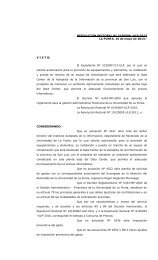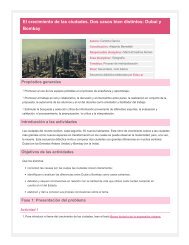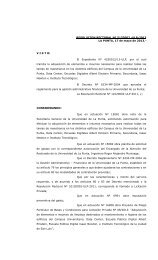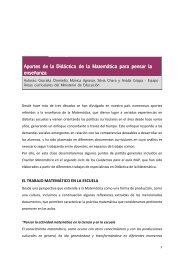e-Book PDF - Universidad de La Punta (ULP)
e-Book PDF - Universidad de La Punta (ULP)
e-Book PDF - Universidad de La Punta (ULP)
Create successful ePaper yourself
Turn your PDF publications into a flip-book with our unique Google optimized e-Paper software.
Hacia un data center Tier IV<br />
Un data center no sólo es construcción, hardware,<br />
software y telecomunicaciones. <strong>La</strong> infraestructura<br />
física <strong>de</strong> un data center la componen una serie <strong>de</strong><br />
subsistemas como el <strong>de</strong> climatización, el eléctrico, el<br />
sistema <strong>de</strong> protección contra incendios y otros.<br />
Adicionalmente se <strong>de</strong>ben tomar en cuenta otros<br />
aspectos como los recursos humanos y los procesos<br />
asociados que <strong>de</strong>ben generar la capacidad <strong>de</strong> mantenerse<br />
en funcionamiento, aunque existan acci<strong>de</strong>ntes<br />
o <strong>de</strong>sastres naturales.<br />
El estándar para data center TIA-942 (Telecomunication<br />
Infrastructure Standard for Data Centers) indica<br />
cómo pue<strong>de</strong>n clasificarse. El estándar habla <strong>de</strong> una<br />
clasificación según los grados <strong>de</strong> disponibilidad <strong>de</strong><br />
un data center. Se clasifican por Tiers y están basados<br />
en información <strong>de</strong>sarrollada por el Uptime Institute,<br />
un consorcio <strong>de</strong>dicado a proveer a sus miembros las<br />
mejores prácticas para mejorar la planificación y gerenciamiento<br />
<strong>de</strong> data centers. Existen cuatro Tiers: I,<br />
II, III y IV, y el estándar <strong>de</strong>scribe <strong>de</strong>talladamente las<br />
recomendaciones para la infraestructura edilicia, <strong>de</strong><br />
seguridad, eléctrica, mecánica y telecomunicaciones<br />
para cada uno <strong>de</strong> ellos. A mayor número <strong>de</strong> Tier mayor<br />
grado <strong>de</strong> disponibilidad.<br />
<strong>La</strong> <strong>ULP</strong> analiza y planifica las acciones necesarias para<br />
tener un data center Tier IV: Un data center <strong>de</strong> este<br />
nivel provee capacidad para realizar cualquier actividad<br />
planeada sin interrupciones en el servicio. Pero,<br />
a<strong>de</strong>más, la funcionalidad es tolerante a fallas y le<br />
permite a la infraestructura continuar operando aún<br />
ante un evento crítico no planeado. Esto requiere,<br />
entre otras cosas, dos líneas <strong>de</strong> distribución simultáneamente<br />
activas, típicamente en una configuración<br />
System+System. Eléctricamente esto significa dos<br />
sistemas <strong>de</strong> UPS in<strong>de</strong>pendientes, cada sistema con<br />
un nivel <strong>de</strong> redundancia N+1. <strong>La</strong> carga máxima <strong>de</strong><br />
los sistemas en situaciones críticas es <strong>de</strong> 90%. Existe<br />
un nivel <strong>de</strong> exposición a fallas, por el inicio una<br />
alarma <strong>de</strong> incendio o porque una persona inicie un<br />
procedimiento <strong>de</strong> apagado <strong>de</strong> emergencia (EPO), los<br />
76 |<br />
Towards a Tier IV Data Center<br />
A data center is not just buildings, hardware, software and telecommunications.<br />
The physical infrastructure of a data center is composed<br />
by a series of subsystems, such as the air conditioning, the electrical<br />
system, fire alarms, among other. Human resources must be consi<strong>de</strong>red,<br />
as well as the processes that must generate the capacity to continue<br />
functioning, even if there are acci<strong>de</strong>nts or natural disasters.<br />
The data center standard TIA-942 (Telecommunication Infrastructure<br />
Standard for Data Centers) show how data centers can be classified.<br />
The standard classifies according to the <strong>de</strong>gree of availability of a<br />
data center. They are classified by Tiers, and this classification is based<br />
on information <strong>de</strong>veloped by the Uptime Institute, a consortium <strong>de</strong>dicated<br />
to provi<strong>de</strong> their members with the best practice to improve the<br />
planning and management of data centers. There are 4 Tiers: I, II, III<br />
and IV, and the standard <strong>de</strong>scribes in <strong>de</strong>tail the recommendations for<br />
the building, security, electrical mechanical and telecommunication<br />
infrastructure for each Tier. The higher Tier number, the more availability<br />
the data center has.<br />
<strong>ULP</strong> analyzes and plans the necessary actions to have a Tier IV data<br />
center: a data center of this level provi<strong>de</strong>s capacity to carry out any<br />
planned activity without interruptions in the service. But, also, functionality<br />
is tolerant to failures and allows the infrastructure to continue<br />
operating even in the face of an unexpected critical event. This requires,<br />
among other things two simultaneously active distribution lines,<br />
typically in a System+System configuration. Electrically this means<br />
two in<strong>de</strong>pen<strong>de</strong>nt UPS systems, each system with a level of redundancy<br />
of N+1. The maximum load of the systems in critical situations is<br />
90%. There is a level of exposure to failure, whether because the fire<br />
alarm starts out, or because a person initiates an emergency shut-

















